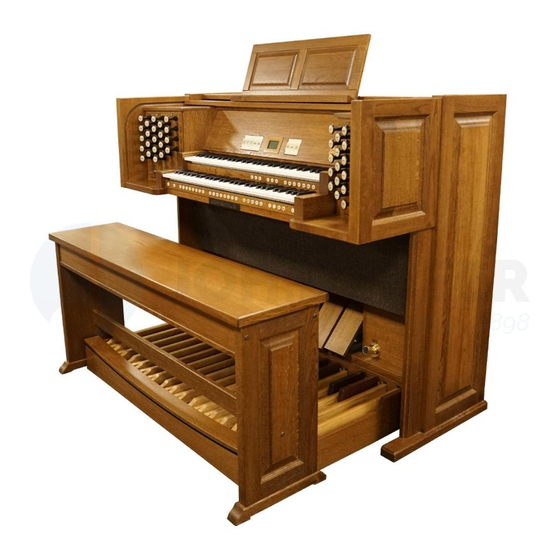
Table of Contents
Advertisement
Advertisement
Table of Contents

Summarization of Contents
Safety Information and Warnings
Safety Precautions for Organ Operation
Essential safety measures for organ operation and handling, including electrical and environmental precautions.
Understanding Organ Symbols
Explanation of warning symbols displayed directly on the organ for hazard identification.
Understanding Manual Symbols
Explanation of warning symbols used within the user manual for important information.
Organ Installation Guide
Organ Placement and Connection Steps
Instructions for positioning the organ on a stable surface and connecting it to a power source.
Music Desk Placement and Adjustment
Guidance on how to correctly position and adjust the height of the music desk.
Organ Power On Procedure
Step-by-step instructions for safely switching on the organ after installation.
Transport and Storage Guidelines
Recommendations for safely moving and storing the organ to prevent damage.
Rolltop Cover Operation
Procedures for opening and closing the organ's protective wooden rolltop cover.
Description of the Johannus Rembrandt Organ
Overview of Main Organ Components
Identification and labeling of the primary physical parts of the organ.
Rembrandt 275 Control Panel Layout
Detailed diagram and labels for the control panel of the Rembrandt 275 model.
Rembrandt 375 Control Panel Layout
Detailed diagram and labels for the control panel of the Rembrandt 375 model.
Rembrandt 395 Control Panel Layout
Detailed diagram and labels for the control panel of the Rembrandt 395 model.
Rembrandt 495 Control Panel Layout
Detailed diagram and labels for the control panel of the Rembrandt 495 model.
Connecting and Activating Accessories
Instructions for connecting external accessories like MIDI devices to the organ.
External Connection Port Descriptions
Description of various ports (MIDI, AUX, PHONES) and their functions.
Organ Operation and Features
Expression Pedal Functions
How expression pedals control the volume of different organ stops.
Acoustics Control
Using rotary controls to adjust digital acoustic effects and echo.
Intonation Settings Explained
Details on main groups and subgroups for organ intonation settings.
Factory Intonation Management
Procedures for saving and restoring factory intonation settings on the organ.
Organ Stops Overview
Explanation of how to activate organ stops and their four main groups.
Coupler Functions and Usage
Detailed explanation of manual and pedal couplers and their effect on stops.
Accessory Features
Description of Chorus, Fix Accessories, Reeds Off, and General Crescendo pedal.
Registration Change Methods
How to use the 0-piston to cancel registrations, either the last or all.
Memory Lock Functionality
How to lock and unlock settings to protect them from accidental changes.
Preprogrammed Memory Locations
Using and programming preset memory locations for organ registrations.
Easy Menu Navigation and Functions
Overview of the Easy Menu system and how to access its various functions.
Capture Memory Programming
How to program and recall registrations using the capture memory feature.
General Volume Control
How to set and save the overall volume level of the organ through the Easy Menu.
Transposer Functionality
Function to shift the organ's pitch by half-tone increments.
Tuning Mode Adjustment
Procedure for adjusting the organ's pitch in fine steps for tuning purposes.
Temperament Selection
How to select from various temperament tuning systems for the organ.
Keyboard Mode Settings
Adjusting key response characteristics like sensitivity and touch for playing feel.
Reset Procedures
How to reset capture memory, MIDI settings, or factory combinations.
Data Dump Mode Operation
Function for sending organ settings to an external storage medium via MIDI.
Demo Song Playback
Instructions on how to select and play the twelve built-in demo songs.
Standard Intonation Setup
Saving desired standard intonation and Chorus ON/OFF settings for startup.
General Crescendo Pedal Usage
Activating and programming the General Crescendo pedal for registration changes.
Programming MIDI Stops
Controlling module voices via MIDI channels and voice numbers for external devices.
Maintenance, Problems, and Warranty
Organ Maintenance Guide
Overview of recommended maintenance tasks for the organ's cabinet and manuals.
Troubleshooting Common Problems
Lists common organ problems, their potential causes, and suggested solutions.
Pedal Repositioning Guide
Step-by-step instructions for repositioning the pedal to resolve operational issues.
Warranty Information and Conditions
Details on warranty terms, conditions, and circumstances that may void the warranty.
MIDI Implementation Details
MIDI Implementation Chart
A comprehensive chart detailing MIDI functions, transmission, and recognition by the organ.
Detailed MIDI Specifications
Further explanation of MIDI specifications including channel assignments and message types.
Default Basic MIDI Channels
Lists default MIDI channel assignments for transmitted and recognized data based on instrument type.
Transmittable Basic Channel Changes
Information regarding how basic MIDI channel changes can be programmed and transmitted.
Transmitted Control Changes
Details on MIDI control change messages transmitted by the organ for volume, pitch, and transposer.
Recognized Control Changes
Details on MIDI control change messages that the organ recognizes from external devices.
Program Change Handling
Explanation of how program changes are handled for organ stops and MIDI programmable stops.
System Exclusive Messages
Explanation of System Exclusive (SysEx) messages used for communication with Johannus devices.
















Need help?
Do you have a question about the REMBRANDT 495 and is the answer not in the manual?
Questions and answers